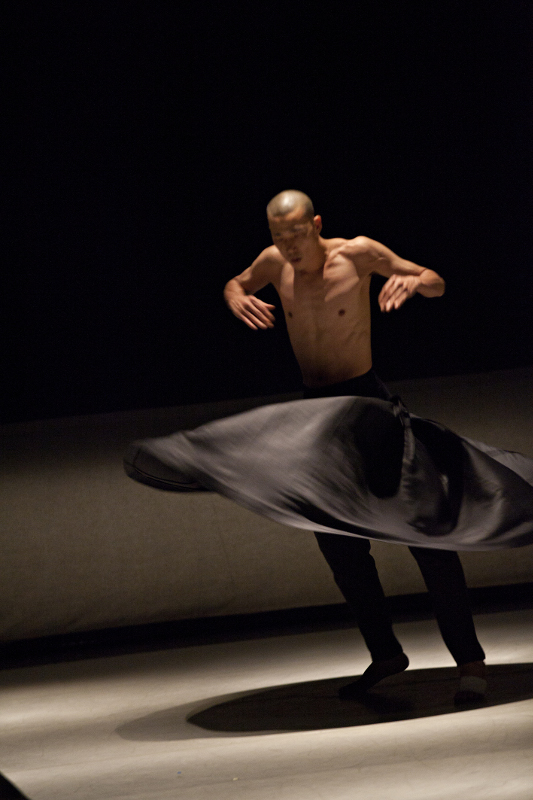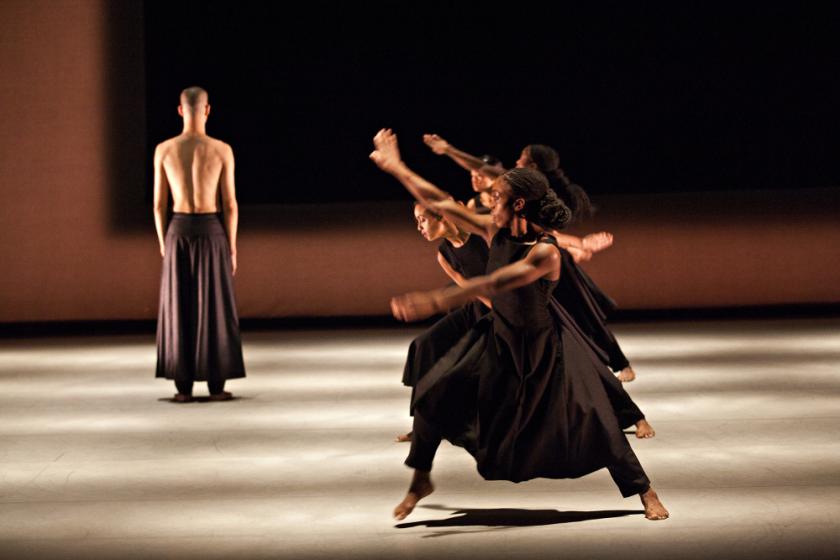This new run of Kaash is an interesting test case for Akram Khan Company as its eponymous founder approaches his retirement from stage performance (forecast for next year). Kaash was Khan's first full-length work, created in 2002 and widely acclaimed at the time. But can Khan's older work stand up after 14 years in which Khan has consistently supplied the British dance scene with some of its most riveting shows (DESH, Gnosis, Sacred Monsters)? And will audiences respond as enthusiastically to Akram Khan pieces without Akram Khan himself on stage?
I think yes, to both questions, though Kaash is perhaps not typical of Khan's more recent work, in that the choreographer's own performance does not seem to be central to the piece's story and hence it is more successful without him than, say, Gnosis, would be. Kaash lacks the explicit character and speech elements which in Khan's later work are usually woven skilfully into the dance: it is in that respect a much more 'typical' dance piece, and frankly it suffers the same problem as most abstract contemporary works in being at least 20% too long. But Kaash still stands up mainly because is the product of a really fine choreographer: Khan, I have always felt, makes dance from the right place (belly? heart? head? all three?). Always, in his shows, however briefly, there will be things which make you think, things which make you feel, and things which grab you in the throat and amaze you. For thinking, Kaash is best seen with its framework of inspiration in mind: the coexisting disciplines of physics and Hindu mythology and their different takes on many worlds, multiverses and creation, preservation and destruction (these latter themes in particular offering interesting parallels with his most recent show, Until the Lions). One still dancer and four moving with strong arms which slice through the air like quarterstaffs - that's like Shiva the many-armed. Light that moves from red to violet suggest beginnings and endings (of the spectrum). Dance formations based on lines or on circles suggest alternately mathematical and mythical ways of thinking about life.
For thinking, Kaash is best seen with its framework of inspiration in mind: the coexisting disciplines of physics and Hindu mythology and their different takes on many worlds, multiverses and creation, preservation and destruction (these latter themes in particular offering interesting parallels with his most recent show, Until the Lions). One still dancer and four moving with strong arms which slice through the air like quarterstaffs - that's like Shiva the many-armed. Light that moves from red to violet suggest beginnings and endings (of the spectrum). Dance formations based on lines or on circles suggest alternately mathematical and mythical ways of thinking about life.
For feeling, there's a haunting duet between one of the Alleyne twins and Sung Hoon Kim (pictured above right). The former has just writhed out an animalistic solo, all backbends, flips, and collapsing limbs when the latter appears, tall, still and collected as a column, and we think, perhaps of a creature struggling out of nothingness and the creator who gives form. But Khan the notorious subverter of traditional power dynamics only introduces binaries like that in order to challenge them, and soon enough Kim is taking on Alleyne's contorted movement language and she is standing tall and regarding him with quizzical composure. When they finally touch - the first time in the show that two dancers have come into close contact - I have no idea any more what the allegory might be, but the atmosphere is electric, and all the more so because this whole episode has taken place in pregnant silence.
Sawhney's score is both hynotic and dramaticFor shock 'n' awe, Kaash has two assets in the shape of composer Nitin Sawhney and artist Anish Kapoor. Kapoor's backcloth is a Rothko-esque black rectangle with fuzzy edges, which seems, black-hole-like, to suck in and warp the light in its vicinity. Sawhney's score has lots of thumping percussion that came rather louder through the speakers than the live music I'm used to in Khan's later shows; monotonous in many ways (though not without small variations, such as the addition of celeste, string, or voice on occasion), the thudding is nevertheless both hypnotic and dramatic. About three quarters of the way through, Khan takes his dancers off stage for Sawhney, Kapoor, and lighting designer Aideen Malone to deliver a set piece of thrilling simplicity: a slow crescendo of noise like an approaching jet engine, against a slow change reduction of light that makes the black rectangle of the backcloth seem to pulse with the same energy that's causing the stalls to rumble and shake. Coup de théâtre: sudden blackout, crash and silence, then a single figure under harsh red light.
It would have made a great ending, but - true to the theme of multiple worlds - it was the jumping-off point for a different iteration of the same patterns as before. The repetition is appropriate to both physics and mythology, perhaps, but it added a little too much length for this (possibly one-dimensional) critic's liking.
- Akram Khan Company perform Kaash at Sadler's Wells until 5 March and on tour in Europe, Bahrain and the UK until 27 May.














Add comment